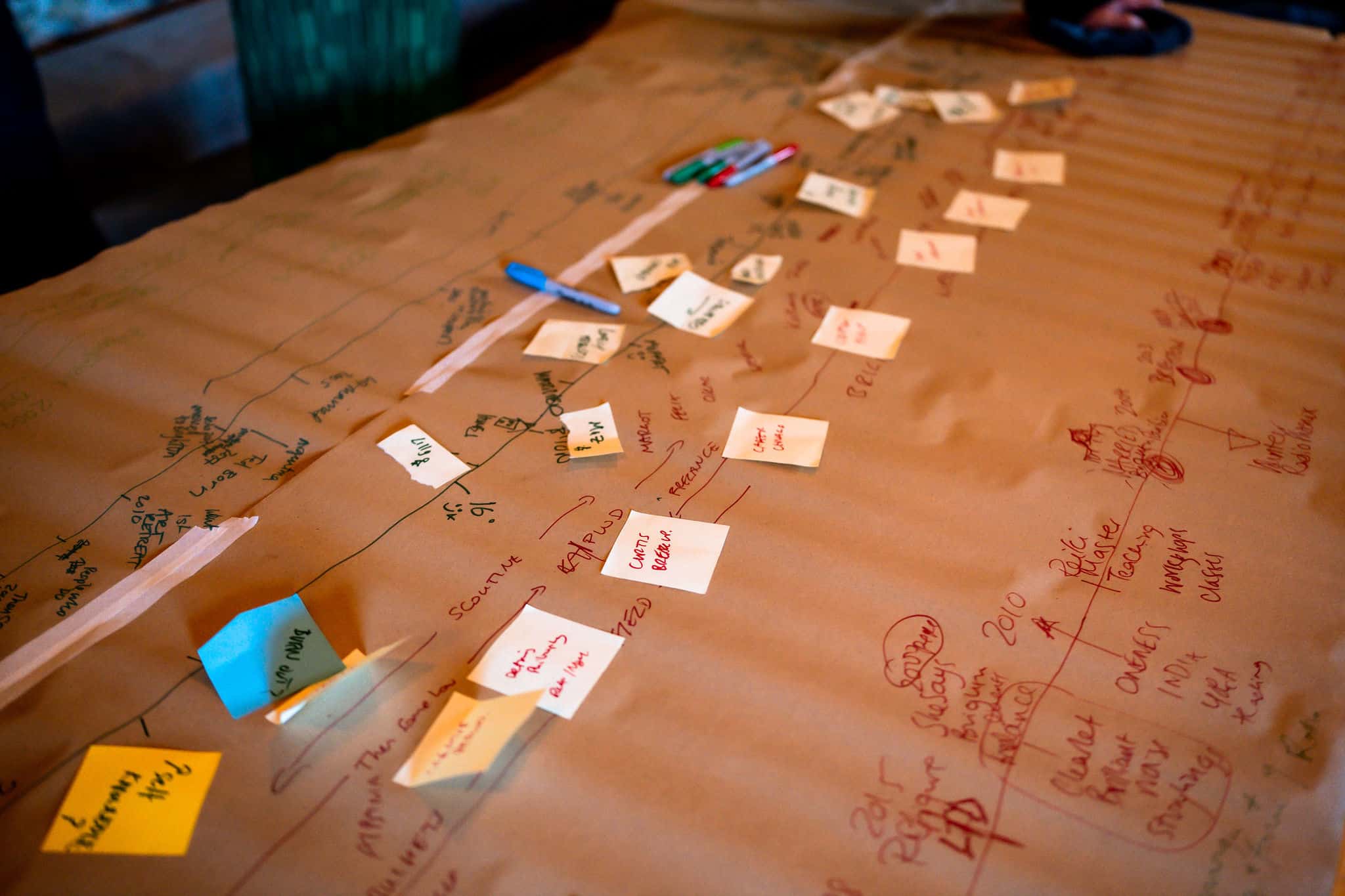Every team starts with an incomplete picture of the people they’re working with, but as you learn more about each other it’ll help you become a high performing team.
Depending on what questions you ask in the Timelining exercise, you learn about what motivates each other. You learn about where you all want to go, and the things that are important to each other outside of work. That’s useful because you need to know the people around you if you’re going to be a high performing team.
It’s where trust comes from. And understanding.
As we’ve written before, lack of trust is at the root of the problems that teams commonly struggle with. These problems cause confusion, misunderstanding, negative morale and can impact entire organisations.
If there’s a lack of trust, team members will be unable to be vulnerable and open with one another. This is a huge waste of time and energy, as team members invest in defensive behaviour instead, and are reluctant to ask for help from – or assist – one another. That stops you being a high performing team.
The Timelining Tool is a way to bring team members closer together, to build trust through empathy.
How to do it
In the first part of the exercise, you work up to today, in part 2 you go beyond, into the future.
What you need:
- A long roll of paper
- A big table, large wall space, or use the floor
- Pens
How much time you need
From 90 mins to 3 hours.
Longer is always better, but not everyone has 3 hours available.
The Ground Rules
- You don’t have to share anything if you don’t want to, it’s great when you do.
- Don’t share anything that makes you feel uncomfortable.
- Don’t share anything outside of the room – ie keep confidentiality.
How to do it:
Get the big roll of brown paper, and roll it out on the table, or wall or floor if you don’t have a table big enough!
Work out who is the oldest, and draw a mark on the left edge of the paper to represent their year of birth.
From this starting date, draw a straight line to the other end of the paper, and mark off the decades to today and for a few years into the future.
Next, get everyone to write down on the line the moments in their lives that are really important:
ie
- When and where you were born
- Where did you live when you were children
- Which schools you went to
- Significant moments in your childhood
- First kiss
- First partner
- Which university you went to
- Death of grandparents
- What was your first job
- Where were you living
- What was the next job
- Why did you leave
- When did you meet your partner
- When did your children get born
All the significant milestones in your life – map them all out on the same piece paper.
Working in and around and over each other, everyone draws their timeline, and then when you’re all done, everyone stands back and each person tells their life story.
It can take a few hours.
You can speed it up by inviting people to tell specific parts of their story: one person tells the first part of their life, and other people will chip in and offer reflections. Then someone else gets to tell the next bit.
It’s rather wonderful if you do give it the proper time it deserves, because you find out all sorts of stuff about each other: what motivated people to do various things in their lives, like moving, or joining organisations, including the current one… it brings you all up to to date.
And often, there’s lots of really rich stuff to be found in the most recent 6 to 12 months.

What you can learn
You will always discover something unexpected, like the time we found out that one person was a champion rodeo rider. Or the time there was a person who had won a Nobel prize, and not everyone in the room knew!
Some other really interesting things can happen – I remember when a quiet member of one team talked about the birth of a child, and how there had been complications for several days. “It was the worst time of my life,” they said. It was awful.
The timelining tool fills in all these blanks about people’s lives. It fills you with surprise and joy about these interesting people that you work with every day and knew nothing about.
It also creates opportunities to talk about patterns that might emerge, to focus on the last 12 months in particular.
Looking ahead
Once you have talked about the past up to the present, then you can extrapolate it forward to where you’re all going, and what’s going to happen to you over the next 5 to 10 years.
Interesting things emerge for example about where people want to live or what they really want to do for a living. And therefore what considerations you might need to give to your own planning.
Maybe they want to retire, or start a family, or… These things are worth knowing!
The more you know about what they hope for (see The Three Questions), the more trust you can build, the more you can build the feeling that we’re all in this together. The more you can be a high performing team.
Advanced Version
Once they’ve drawn the timelines, and we’ve talked about them, I’ll sometimes ask everyone to annotate when they were happiest, and when they were least happy.
What were the really high points and the low points of emotion? This can be particularly good when you’re focusing on the most recent 12 months.
It creates an opportunity for everyone to talk about the things that were or weren’t working for them, which allows you to talk about some patterns that might be going on in the group.
Here’s an Example of Timelining in Action:
We’ve been helping a large organisation prototype how to build networks within their organisation.
We ran a series of pilots, and what we discovered is the best way to build networks is to first build trust between everybody.
Because the work of building networks is not about forming projects and working groups, sure those might be outputs of forming a network, but that is not the way you build trust.
The network forming sessions that worked best were the ones that felt less like a “we need to form a network, what shall we do” meeting, and were more “let’s get to know each other and talk about things that we share, and then we can work out what to do” meeting.
Otherwise, it’s just another thing that people have to do.
There was an interesting moment with one of the senior managers of one particular group.
We said, “Let’s do the Timelining exercise.”
They said. “I’m not really sure about that… it feels a bit out there… a bit woo woo… I’m not sure that people will like it… I’m not sure it’s appropriate, I don’t think it’s professional enough…”
We said, “I think we should just do it and see. Let us take a risk with you.”
So we did.
Immediately after the Timelining session, the manager said, “I’m really glad we did this, it was so valuable, just look at the way we’re all talking to each other now.”
We can understand the resistance.
For most of us, it’s not our default position to recognise the value of these kinds of trust building activities. They do not feel like real work. But when you make time for them, it’s incredibly valuable.
What you find out about each other is so interesting. Often weird coincidences pop out, and suddenly you have a real connection with your colleagues.
And then you can do great work with them.
If you need some help with working on this – get in touch, at ThenSomehow we help you and your team build emotional literacy, increase empathy, and help you see the world differently, giving you practical tools to shift the stuff that’s stuck.
If you’d like to discuss how we can help your team be more high performing, get in touch here.
